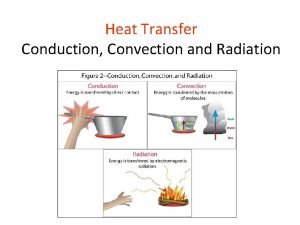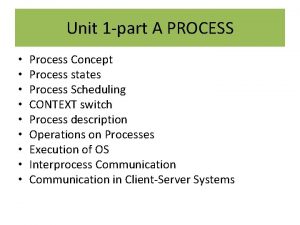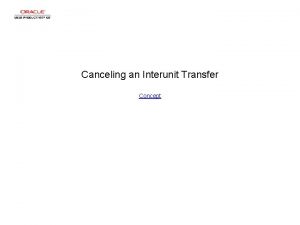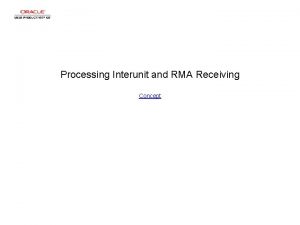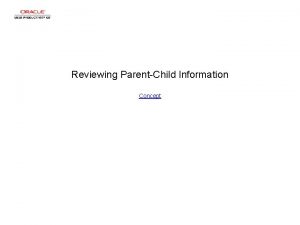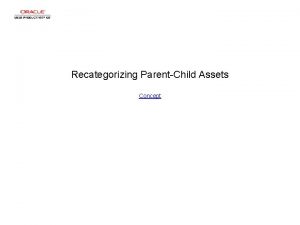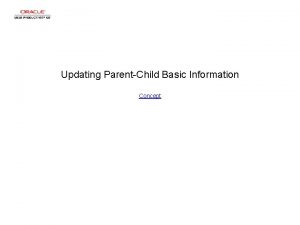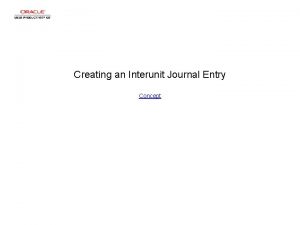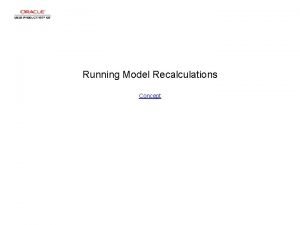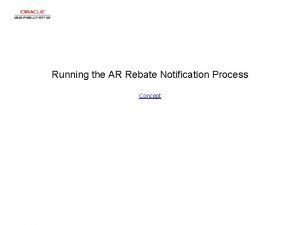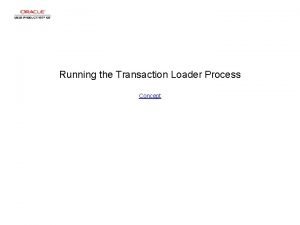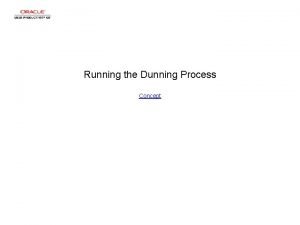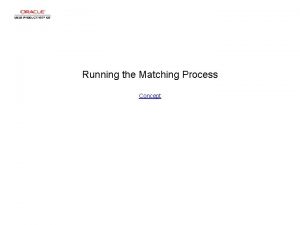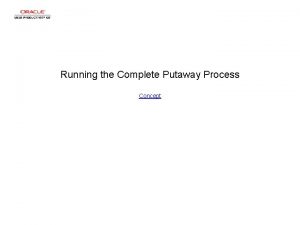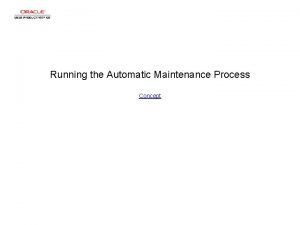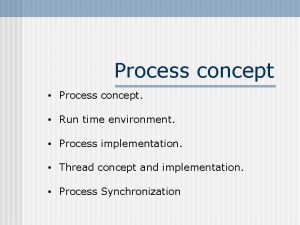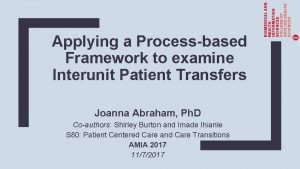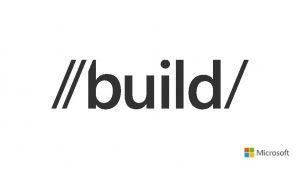Running the Interunit ParentChild Transfer Process Concept Running





















































- Slides: 53

Running the Interunit Parent-Child Transfer Process Concept

Running the Interunit Parent-Child Transfer Process

Running the Interunit Parent-Child Transfer Process Step 1 Begin by navigating to the Parent-Child IU Transfer page. Click the Scroll Down arrow.

Running the Interunit Parent-Child Transfer Process Step 2 Click the Asset Management menu.

Running the Interunit Parent-Child Transfer Process Step 3 Click the Asset Transactions menu.

Running the Interunit Parent-Child Transfer Process Step 4 Click the Parent-Child Relationship menu.

Running the Interunit Parent-Child Transfer Process Step 5 Click the Inter. Unit Parent-Child Trans menu.

Running the Interunit Parent-Child Transfer Process Step 6 You can run this process by searching for an existing Run Control ID or you can add a new value. Creating a Run Control ID that is relevant to the process may help you remember it for future use. Click the Add a New Value tab.

Running the Interunit Parent-Child Transfer Process Step 7 Enter the desired information into the Run Control ID field. Enter "interunit".

Running the Interunit Parent-Child Transfer Process Step 8 Click the Add button.

Running the Interunit Parent-Child Transfer Process Step 9 Use the Parent-Child IU Transfer page to enter request parameters. These parameters will be used to define the processing rules and data to be included when the process is run.

Running the Interunit Parent-Child Transfer Process Step 10 You use the interunit parent-child process to transfer an asset between business units. The Unit field identifies the source unit of the parent-child asset. For this exercise, accept the default value.

Running the Interunit Parent-Child Transfer Process Step 11 Use the Transaction Date field to specify when this transfer will occur. For this exercise, accept the default date.

Running the Interunit Parent-Child Transfer Process Step 12 Use the New Unit field to designate the business unit to which you are transferring this asset. Click in the New Unit field.

Running the Interunit Parent-Child Transfer Process Step 13 Enter the desired information into the New Unit field. Enter "US 003".

Running the Interunit Parent-Child Transfer Process Step 14 Use the Accounting Date field to specify the accounting period in which to book this transaction. For this exercise, accept the default date.

Running the Interunit Parent-Child Transfer Process Step 15 Use the Convention list to designate the transaction period association with this transfer.

Running the Interunit Parent-Child Transfer Process Step 16 Click in the Parent Asset field.

Running the Interunit Parent-Child Transfer Process Step 17 Use the Parent Asset field to identify the parent asset from which you are transferring assets. Enter the desired information into the Parent Asset field. Enter "MMFACLTY 0009".

Running the Interunit Parent-Child Transfer Process Step 18 Click in the Profile ID field.

Running the Interunit Parent-Child Transfer Process Step 19 Use the Profile ID field to select a valid ID for the new business unit to set up book reporting. Enter the desired information into the Profile ID field. Enter "CABLE".

Running the Interunit Parent-Child Transfer Process Step 20 Click the Select All button.

Running the Interunit Parent-Child Transfer Process Step 21 Click the Save button.

Running the Interunit Parent-Child Transfer Process Step 22 Click the Run button.

Running the Interunit Parent-Child Transfer Process Step 23 Use the Process Scheduler Request page to enter or update parameters, such as server name and process output format.

Running the Interunit Parent-Child Transfer Process Step 24 You must select a Server Name to identify the server on which the process will run. If you use the same Run Control ID for subsequent processes, the server name that you last used will appear by default. Click the Server Name list.

Running the Interunit Parent-Child Transfer Process Step 25 Click the PSNT list item.

Running the Interunit Parent-Child Transfer Process Step 26 Use the Type list to select the type of output you want to generate for this job. Your choices are Email, File, Web, and Window.

Running the Interunit Parent-Child Transfer Process Step 27 Use the Format list to define the output format for the report. The values are dependent upon the Process Type you selected. In this example, the default value is TXT.

Running the Interunit Parent-Child Transfer Process Step 28 Click the OK button.

Running the Interunit Parent-Child Transfer Process Step 29 Note that a Process Instance number appears. This number helps you identify the process you have run when you check its status.

Running the Interunit Parent-Child Transfer Process Step 30 Click the Process Monitor link.

Running the Interunit Parent-Child Transfer Process Step 31 Use the Process List page to view the status of submitted process requests.

Running the Interunit Parent-Child Transfer Process Step 32 The Interunit Parent-Child Transfer Process completed successfully.

Running the Interunit Parent-Child Transfer Process Step 33 Next, navigate to Load Transactions into AM page where you will run the process to load the transfer data into the Asset Management tables. Click the Asset Management menu.

Running the Interunit Parent-Child Transfer Process Step 34 Click the Send/Receive Information menu.

Running the Interunit Parent-Child Transfer Process Step 35 Click the Load Transactions menu.

Running the Interunit Parent-Child Transfer Process Step 36 Click the Load Transactions into AM menu.

Running the Interunit Parent-Child Transfer Process Step 37 Click the Add a New Value tab.

Running the Interunit Parent-Child Transfer Process Step 38 Enter the desired information into the Run Control ID field. Enter "loadtrans".

Running the Interunit Parent-Child Transfer Process Step 39 Click the Add button.

Running the Interunit Parent-Child Transfer Process Step 40 Use the Load Transactions into AM page to enter your request parameters. These parameters will be used to define the processing rules and data to be included when the process is run.

Running the Interunit Parent-Child Transfer Process Step 41 Click the Process Frequency list.

Running the Interunit Parent-Child Transfer Process Step 42 Click the Once list item.

Running the Interunit Parent-Child Transfer Process Step 43 Click the Save button.

Running the Interunit Parent-Child Transfer Process Step 44 Click the Run button.

Running the Interunit Parent-Child Transfer Process Step 45 Click the Server Name list.

Running the Interunit Parent-Child Transfer Process Step 46 Click the PSNT list item.

Running the Interunit Parent-Child Transfer Process Step 47 Click the OK button.

Running the Interunit Parent-Child Transfer Process Step 48 Note that a Process Instance number appears. This number helps you identify the process you have run when you check its status.

Running the Interunit Parent-Child Transfer Process Step 49 Click the Process Monitor link.

Running the Interunit Parent-Child Transfer Process Step 50 You successfully ran the process to load the transfer data into the Asset Management tables.

Running the Interunit Parent-Child Transfer Process Step 51 You have successfully run the interunit parent-child transfer process. End of Procedure.
 Once upon a time there lived a boy
Once upon a time there lived a boy Running running running
Running running running A wave is a disturbance that transfers
A wave is a disturbance that transfers Hát kết hợp bộ gõ cơ thể
Hát kết hợp bộ gõ cơ thể Lp html
Lp html Bổ thể
Bổ thể Tỉ lệ cơ thể trẻ em
Tỉ lệ cơ thể trẻ em Gấu đi như thế nào
Gấu đi như thế nào Chụp phim tư thế worms-breton
Chụp phim tư thế worms-breton Hát lên người ơi
Hát lên người ơi Các môn thể thao bắt đầu bằng tiếng nhảy
Các môn thể thao bắt đầu bằng tiếng nhảy Thế nào là hệ số cao nhất
Thế nào là hệ số cao nhất Các châu lục và đại dương trên thế giới
Các châu lục và đại dương trên thế giới Công thức tính độ biến thiên đông lượng
Công thức tính độ biến thiên đông lượng Trời xanh đây là của chúng ta thể thơ
Trời xanh đây là của chúng ta thể thơ Mật thư tọa độ 5x5
Mật thư tọa độ 5x5 Làm thế nào để 102-1=99
Làm thế nào để 102-1=99 Phản ứng thế ankan
Phản ứng thế ankan Các châu lục và đại dương trên thế giới
Các châu lục và đại dương trên thế giới Thể thơ truyền thống
Thể thơ truyền thống Quá trình desamine hóa có thể tạo ra
Quá trình desamine hóa có thể tạo ra Một số thể thơ truyền thống
Một số thể thơ truyền thống Bàn tay mà dây bẩn
Bàn tay mà dây bẩn Vẽ hình chiếu vuông góc của vật thể sau
Vẽ hình chiếu vuông góc của vật thể sau Thế nào là sự mỏi cơ
Thế nào là sự mỏi cơ đặc điểm cơ thể của người tối cổ
đặc điểm cơ thể của người tối cổ V cc
V cc Vẽ hình chiếu đứng bằng cạnh của vật thể
Vẽ hình chiếu đứng bằng cạnh của vật thể Tia chieu sa te
Tia chieu sa te Thẻ vin
Thẻ vin đại từ thay thế
đại từ thay thế điện thế nghỉ
điện thế nghỉ Tư thế ngồi viết
Tư thế ngồi viết Diễn thế sinh thái là
Diễn thế sinh thái là Các loại đột biến cấu trúc nhiễm sắc thể
Các loại đột biến cấu trúc nhiễm sắc thể Số nguyên là gì
Số nguyên là gì Tư thế ngồi viết
Tư thế ngồi viết Lời thề hippocrates
Lời thề hippocrates Thiếu nhi thế giới liên hoan
Thiếu nhi thế giới liên hoan ưu thế lai là gì
ưu thế lai là gì Khi nào hổ con có thể sống độc lập
Khi nào hổ con có thể sống độc lập Khi nào hổ con có thể sống độc lập
Khi nào hổ con có thể sống độc lập Sơ đồ cơ thể người
Sơ đồ cơ thể người Từ ngữ thể hiện lòng nhân hậu
Từ ngữ thể hiện lòng nhân hậu Thế nào là mạng điện lắp đặt kiểu nổi
Thế nào là mạng điện lắp đặt kiểu nổi Real self explanation
Real self explanation Perbedaan selling concept dan marketing concept
Perbedaan selling concept dan marketing concept What is steady flow process in thermodynamics
What is steady flow process in thermodynamics Rigid tank thermodynamics
Rigid tank thermodynamics Radiation example
Radiation example Multiple sclerosis concept map
Multiple sclerosis concept map Discuss in detail the concept and process of hydrosere'
Discuss in detail the concept and process of hydrosere' Pollination mind map
Pollination mind map What is process concept
What is process concept

















































